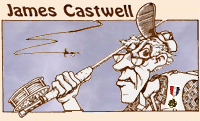|
A graphite fly-rod does not know or care that it
is straight. It does know it is round, pretty much
so anyway. It is made by wrapping a cloth on a
long tapered steel rod. It is rolled, cooked,
sanded and finished. What goes into the cloth
is what makes the biggest difference. Stuff
like graphite, boron, fiberglass, titanium
and bulloneyium. The ratio between the stuff
in the cloth and the taper of the steel rod
gives all rods their characteristics. As in
fast, medium, slow and so forth.
When a rod bends (as in casting) it goes from
round to oval, and one side stretches and the
other side compresses. The ability and the speed
which it returns to round determines how fast a
rod is. If it cannot return fast to round it
is considered a slow rod. This is not to say it
is bad, there are many uses for such a rod.
Generally speaking, the more graphite in the
rod, the faster it will return to round, i.e.
a faster rod.
Let's take a look at one single place in a cast.
The line is rolling out on the back-cast, the rod
is held firmly at about ten degrees above horizontal
in preparation for a full-pull double-haul. Various
casters using various rods will employ various
degrees of elevation at this point. Some flat
out at 180 degrees, others raising the rod up
to 45 or 50 degrees. There is no real agreement
on this angle. It will with all casters however
produce differing results.
Now add this. Presuming your timing is exact and
you start the DH while there is no load on the
rod (speeding up the line) you are giving the
rod less mass-weight to pull (load) against.
This means you can load the rod with more
thrust without overloading it.
If you start the DH after you have started the rod
forward and it is already becoming loaded, you must
not use as much force on the DH for fear of
overloading the rod. Add to this the improbability
of exact timing on repetitive casts, the exact
amount of fly-line in the air at each cast, whether
any line was, or was not let out into the last
backcast and you can see how difficult the game
of distance casting can become; or, for many,
how interesting.
You can, for instance, force the DH too late, while
the rod is almost vertical and easily break
the rod tip. Some rods require a short, sharp DH
pull, others a long easy DH pull. These will result
in a change in loop shape and distance. Remember
too, each of these elements change on each cast
as more or less fly-line is airialized. There are
also differences with different types of rods and,
yes, each fly-line used on them only adds more
problems. Lots of fun!
If you are new to casting, this doesn't mean squat,
sorry about that. But I get some of the old-timers
beating on me about stuff like this.
~ James Castwell
|



